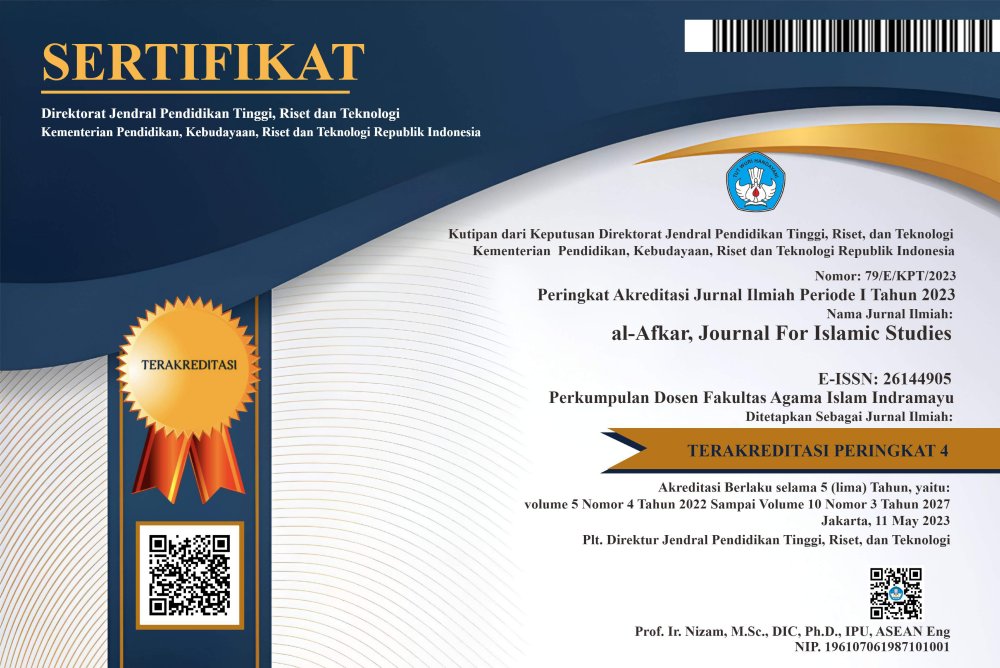Ila Mamati's Prayer Method of Memorizing the Al-Qur’an at High School at the Tahfidzul Qur'an Islamic Boarding School, Nurul Istiqalal Wonosari Klaten
DOI:
https://doi.org/10.31943/afkarjournal.v8i1.1577Keywords:
Method, Ila Mamati PrayerAbstract
Prayer ila mamati is a phrase taken from Arabic. Sholati means my prayer, ila means until, while mamati means my death. So "my prayers until my death" means that I, as a memorizer of the Qur'an, have the responsibility to uphold both obligatory and sunnah prayers, try to be istiqamah and muraja'ah of the Qur'an in sunnah prayers until I die. Tahfidul Qur'an Nurul Istiqlal Islamic Boarding School Wonosari Klaten is a non-formal educational institution whose address is Pandanan Village, Wonosari District, Klaten Regency, Central Java Province. This article is included in qualitative research with a type of approach, namely literature study. In the literature study, researchers carried out activities to collect literature related to the ila mamati prayer method in facilitating memorization of the Al-Qur'an. This research uses books and other literature as the main object. So the type of research used is qualitative research. The implementation of the shalati ila mamati method is carried out when we pray. Because in prayer we definitely read the verses in the Koran, both short and long verses. However, this method is prioritized during sunnah prayers. The principles of the Illa Mamati prayer method are as follows: the principle of motivation, the principle of having the Al-Qur'an memorized, the principle of istiqomah. Applying a learning method in a learning activity is not as easy as imagined, especially in memorizing the Al-Qur'an. Sometimes how it happens and the reality that we find when we go directly into the field does not match what is expected with the theory learned when using this learning method. In every implementation or implementation there are definitely inhibiting and supporting factors that influence the use of the method, as well as when implementing it.
Downloads
References
Ahsin Sakho, Muhammad. Menghafalkan Al-Qur’an. Jakarta Selatan: PT Qaf Media Kreativa, 2017.
Bliss, M. A., Gul, F. A., & Majid, A. (2011). Do political connections affect the role of independent audit committees and CEO duality? Some evidence from Malaysian audit pricing. Journal of Contemporary Accounting & Economics, 7(2), 82-98.
Miswardi, Dicky. Metode Sholati Ila Mamati. Semarang: Taujih Sukoharjo, 2018.
Muhammad, D. K. A. S. (2018). Menghafalkan Al-Qur'an. Manfaat Keutamaan, Keberkahan dan Metode Praktisnya. Jakarta: PT Qaf Media Kreativa.
Mukholisoh, Faizatul, Anwar Sa’dullah, and Nur Hasan. "Pelaksanaan Metode Muroja’Ah Tahfidz Al-Qur’an Di Ma’Had Al-Ulya Man Kota Batu." Vicratina: Jurnal Ilmiah Keagamaan 4.3 (2019): 191-196.
Mukholisoh, Faizatul, Anwar Sa’dullah, and Nur Hasan. "Pelaksanaan Metode Muroja’Ah Tahfidz Al-Qur’an Di Ma’Had Al-Ulya Man Kota Batu." Vicratina: Jurnal Ilmiah Keagamaan 4.3 (2019): 191-196.
Ni'mah, F. Z., & Khoiruddin, M. A. (2021). Pengaruh self-esteem dan optimisme masa depan Siswa Menengah Kejuruan (SMK) berbasis pesantren. Indonesian Journal of Islamic Education Studies (IJIES), 4(1), 121-136.
Nur Adzimah, Joko Sarjono, Indah Nurhidayati, Penerapan Metode Muraja’ah Sahlaati Ila Mamati Pada Program Tahfizh, jurnal MODELING, Volume 10, Nomor 2, Juni 2023
Shihab, M Quraish. (2003). Wawasan AlQur’an. Bandung: Mizan
Sukmadinata, S. N. "Metode penelitia." Bandung: PT remaja rosdakarya (2005).
Sugiyono, (2007). Metode Penelitian Kuantitatif, Kualitatif dan R&D. Bandung: Alfabeta
Downloads
Published
How to Cite
Issue
Section
License
Copyright (c) 2025 Luthfi Badrus Tsani, Fauzi Muharom

This work is licensed under a Creative Commons Attribution 4.0 International License.



















